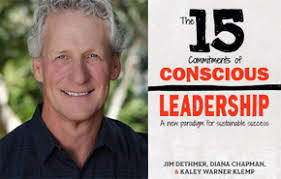
Podcast Summary: Shift from Victim Consciousness, Reduce Drama, Practice Candor and More – Jim Dethmer
Amazon #ads
4 Simple Questions on Inquiry
– Is it true? E.g. Covid conspiracies.
– Can I know for certain it’s true? E.g. Source.
– When I believe the thought, how do I react? E.g. Fear.
– Who would I be without the thought? E.g. At peace.
Process
1 – Begin with breathing, and specifically, conscious breathing. Simply breathe with a four-second inhale and a four-second exhale. Breathe into the belly and bring your attention to the breath, so you feel the breath going in, going down, the pause in between the inhale and the exhale, and then you feel it going back out to the pause. It changes your blood and brain chemistry. Where do you most feel the breath in the body? Go there. And leave your attention there for just 30 seconds. And when it wanders, just bring it back.
2 – After breathing ask ‘What feeling is here now?’. Simplify to the core three: sad, angry, scared. Any time you say the word ‘I feel’ followed by the word ‘that,’ it’s not going to be a feeling. It’s going to be a thought. So there’s a thought and there’s a feeling, what we often call the cognitive emotive loop.
3 – Then ask where is the feeling? E.g. In my belly.
4 – Then ask what the sensations are doing. E.g. Twisting.
5 – Next question ‘Could you place your attention on the sensations for some moments. E.g. Just let the fear be, let the belly gurgle, let the tears fall.
6 – Finally ask what is this feeling here to show you? E.g. Anger is the energy of stop or boundaries. Sadness is something needs to be grieved or let go of.
Are you above or below the line?
Q1 – Where are you? In this now moment you’re either above or below the line. Above the line is present, available, in a state of trust. Below the line is in threat, contracted.
Q2 – Can you accept yourself for being reactive? The antidote is acceptance.
Q3 – Are you willing to shift?
Q4 – How are you going to shift?
Self Blame
I’m going to blame you, I’m going to blame me, or I’m going to blame them. But all three of those are still keeping me in a contracted consciousness, where I’m committed, and this is a key phrase, to being right, that somebody screwed it up and needs to have done it differently. Blame is always a limiting, contracting, fault-finding energy. In a high-learning state, what if we shift to there’s no need to blame anybody or hold anybody accountable. What about if we take responsibility for what we can learn?
Look at what I’m currently complaining about. What could we learn from that and get genuinely curious?
Commitments
– We commit to being close and to removing all barriers to closeness.
– We commit to reveal and not conceal as a means to creating intimacy, not just physical intimacy.
– I commit to be responsible for my own happiness and well-being.
– I don’t ever want you, in our relationship, to do anything from obligation.
Candid Conversations
– What we call candor begins with the ability to differentiate facts from stories, facts from data, facts of what is totally unarguable. Facts are that which all reasonable people would agree to. Instead of stories you tell yourself e.g. why someone is upset and the excuses you’ll give.
– Then you reveal your stories, holding them lightly. E.g. Hey, when I look over, it looks like you’re upset. I’m making up the story that you’re upset and rather than get all scared and reactive to that, first thing I do is just want to tell you I’m making up that story and I want to check it out with you. Are you upset? And by the way, when I make up the story that you’re upset, I noticed I get defensive.
– Candor and conscious listening go hand in glove. E.g. Hey, I just want to tell you. I’ve got a judgment coming up in me about so-and-so.
– I’m more interested in something other than just being right.
To me, by me, through me, as me – Michael Beckwith’s Model
– To me: It’s happening to me. So we’re in victimhood or victim consciousness. And I’ll just pause here and say in parentheses, there are true victims in the world. Let’s just stipulate to that. But that’s different than victim consciousness.
– By me: This is creatorship. This is a state of empowerment. This is a place where I’m no longer seeing myself as at the effect of, now I’m seeing myself as responsible for and creator of my experience.
– Through me: Is there something else going on in the world other than me and my purpose-driven life, my authorship of what I want in life? Is there anything else going on? What does like want to do through me? Through me experience is unbelievably fun, synchronicity. Musicians say, all of a sudden music was coming through me.
– As me: It’s non-duality, it’s oneness, it’s the blurring of a personal self. Even though there is a personal self, it’s being fully human, but being in the dance of beingness. This idea of becoming one.
Questions to Ask to Figure Things Out
– What do you want? Keep asking yourself this.
– What do you really want? Even deeper question, forget the identitiy you have and the roles you have to fill. What do you really want?
– What are you willing to put at risk for full aliveness? We tend to drift towards pseudo community. Then we tell the truth. Either intentionally, accidentally, skillfully, unskillfully, and then we go into the tunnel of chaos. Then if we value learning, we come out on the other side in authentic community. Are you willing to put your financial security at risk for full of aliveness? Are you willing to put some relationships at risk? Are you willing to put your reputation at risk? Are you willing — what are you willing to put?”
– What won’t you put at risk for full aliveness? So you know your limits.
The Four Pillars of Integrity from Gay and Katie Hendricks
1 – Do you have any unsaids?
2 – Do you have any unkepts?
3 – Do you have any unowned?
4 – Do you have any unfelts?
The Change Formula
It’s V times D, plus FS, greater than R, equal C. All it means is this, in order to produce change, which is the C something has to be greater than the resistance to change, which we all have. The something that will produce change by overcoming the resistance is V times D, vision times dissatisfaction. In other words, you got a multiplier.





